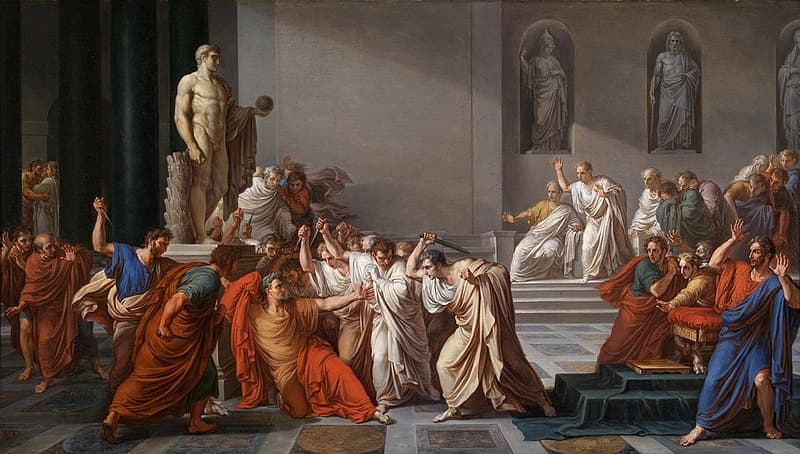We have musically explored the Old Testament, the original Hebrew Bible, and the sacred scriptures of the Jewish faith.
The second section of the Bible is the New Testament, written by Christians in the first century AD. It is a vast library of stories, songs, poetry, letters, literature, and history collected in 27 books. At its core are the four Gospels (Matthew, Mark, Luke, and John), which tell the story of Jesus. The NT also contains the “Letters,” sometimes referred to as epistles, written by Christian leaders to provide guidance for early church communities.
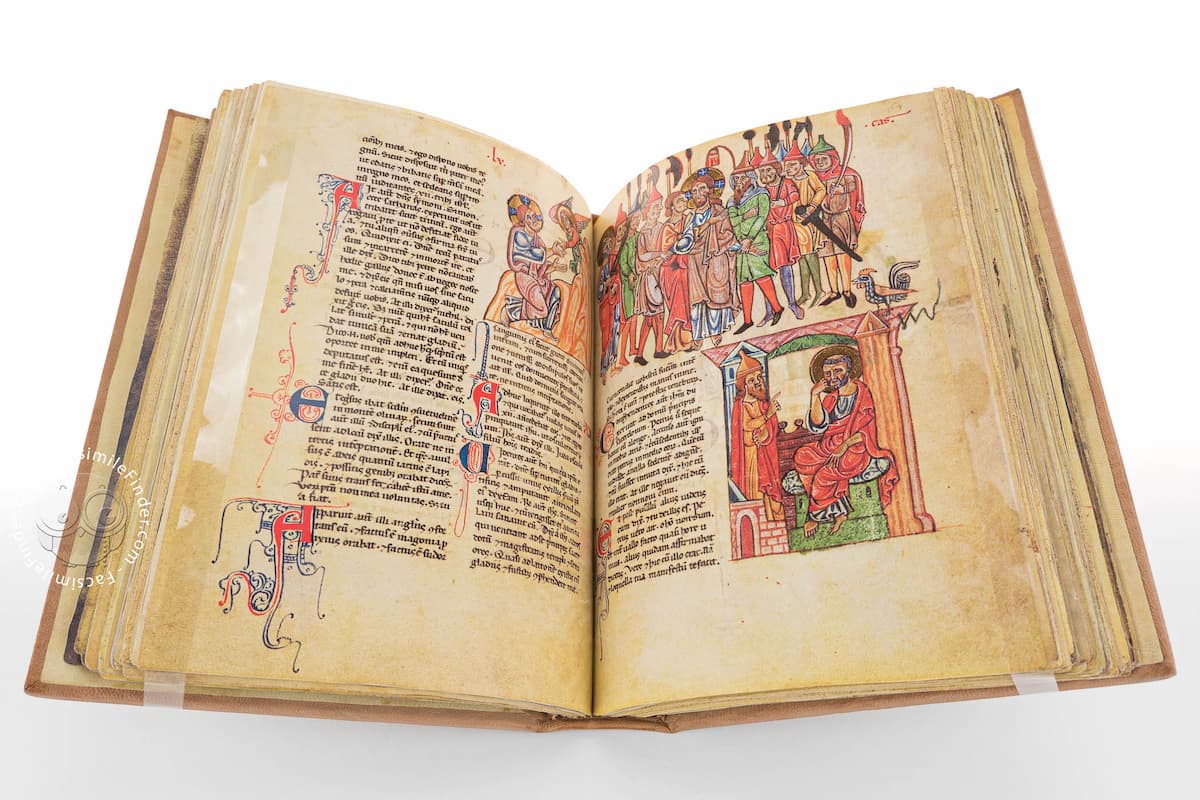
New Testament, Vatican City, Biblioteca Apostolica Vaticana, Vat. lat. 39 © facsimilefinder.com
There is hardly a story in the books of the New Testament which hasn’t inspired a musical setting. Clearly, the Nativity, the account of the birth of Jesus, is one of the most popular stories, and it has received countless musical settings. Let’s start our musical exploration of the New Testament with the aptly named “Christmas Cantata” by 17th-century Roman composer Alessandro Stradella.
Alessandro Stradella: Christmas Cantata (Cristina Miatello, soprano; Caterina Calvi, contralto; Roberto Abbondanza, bass; Enrico Casazza, violin; Isabella Longo, violin/viola; Francesco Ferrarini, cello; Roberto Loreggian, organ; Enrico Casazza, cond.)
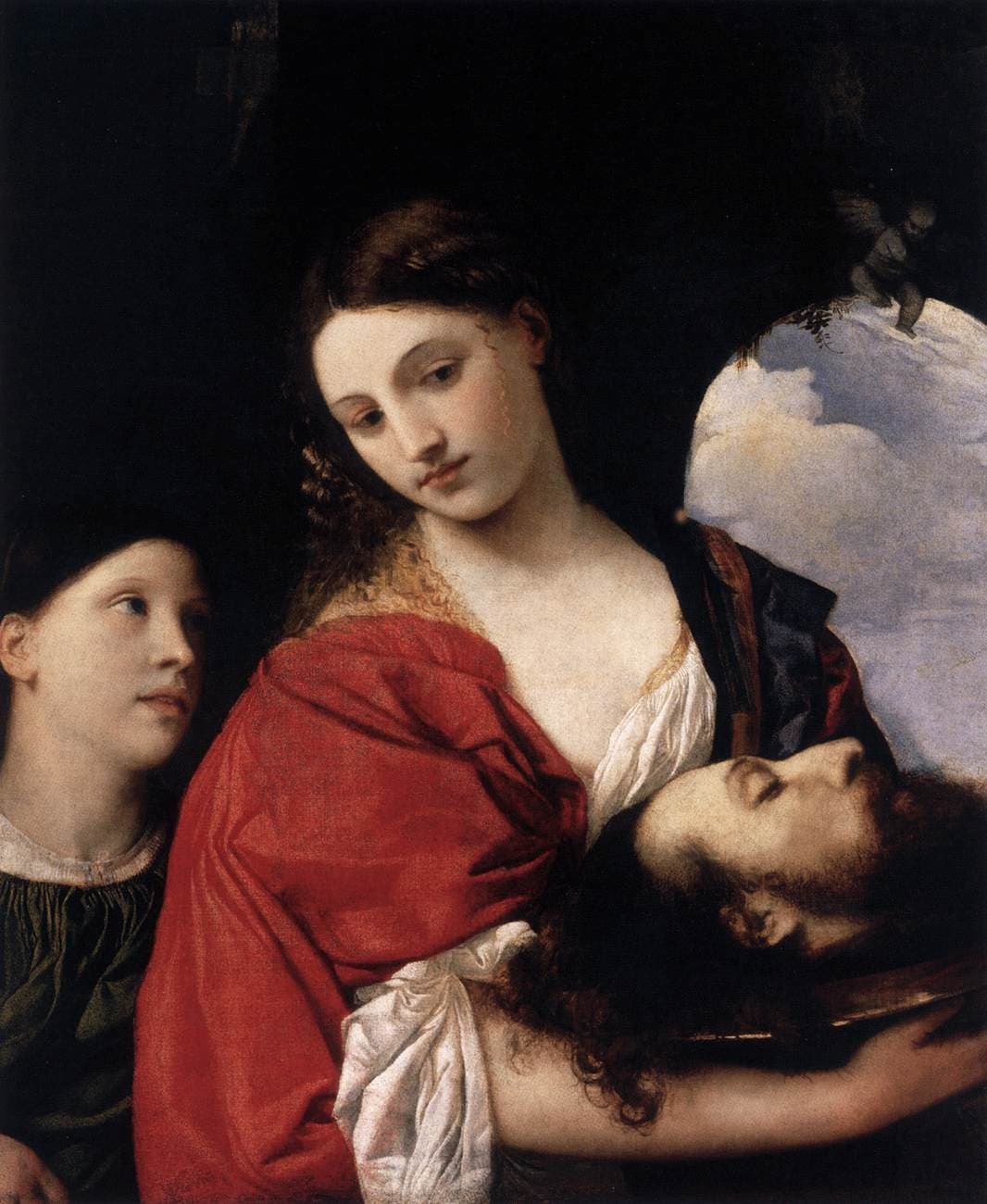
Titian: Salome with the Head of John the Baptist
Do you know the name of the most famous dancing girl in the New Testament? That honor surely goes to Salome, the young daughter of Herodias, who was married to King Herod. In honor of the King’s birthday, he held a great feast and invited all the princes and nobles of his kingdom. While they were eating and drinking, Salome entertained the guests with a highly erotic dance. Herod was rather excited and pleased, and he said to her, “Ask whatever you want, and I will give it to you.” He swore a solemn oath that he would give her whatever she wanted, and Salome went to her mother and asked what she should wish for. A year earlier, Herod had imprisoned John the Baptist, and Herodias had felt insulted by the great prophet. As such, she instructed Salome to ask for the head of John the Baptist on a plate. The king was horrified at the request, but since he was ashamed to break his word in the presence of his princes, he ordered that the head of John the Baptist should be cut off. The severed head was put upon a plate, and Salome gave it to her mother. Have a listen to how Richard Strauss musically encoded Salome’s “Dance of the Seven Veils.”
Richard Strauss: Salome, “Dance of the Seven Veils” (City of Birmingham Symphony Orchestra; Andris Nelsons, cond.)
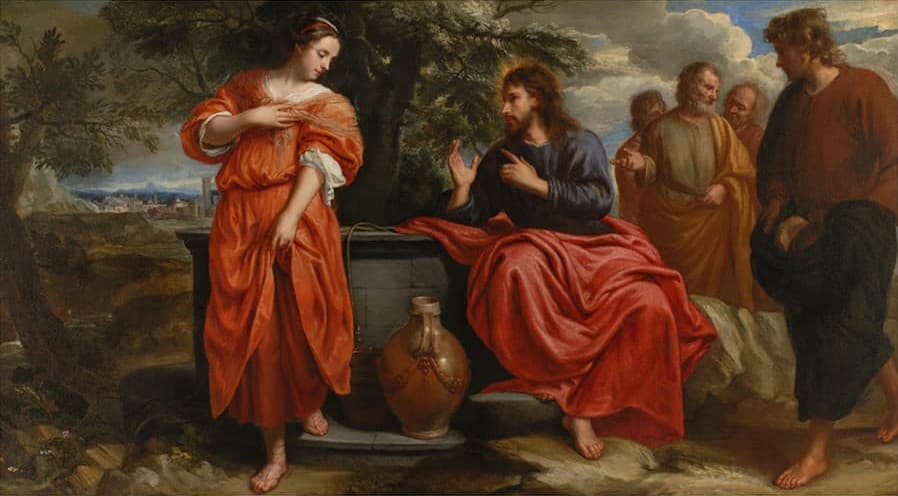
Jacob van Oost: Christ and the Samaritan Woman at the Well
When Jesus walked from Jerusalem to Galilee, he crossed the land of Samaria. The Samaritans hated the Jews, and they worshipped their Lord with their own temples and their own priests. One morning Jesus rested beside an old well dug by Jacob near the foot of Mount Gerizim. He was thirsty and looked into the deep well but had no rope to draw up some water. At that moment, a Samaritan woman came to the well with a water jar and a rope. Jesus asked her for a drink, and the woman scolded him with the words, “How is that you a Jew, ask a drink from a Samaritan woman?” So Jesus told her that whoever drinks the well water will be thirsty again, but that the “water I shall give leads to everlasting life.” They continued to converse, and eventually, the woman recognized that Christ was speaking to her. She ran back to her town and came back to the well with many of her people. Then she asked Jesus to stay with them and teach them, and many believed that Christ was indeed the Savior of the world.
Ladislav Kubik: Sinfonietta No. 2, “Jacob’s Well” (Prague Radio Symphony Orchestra; Vladimír Válek, cond.)
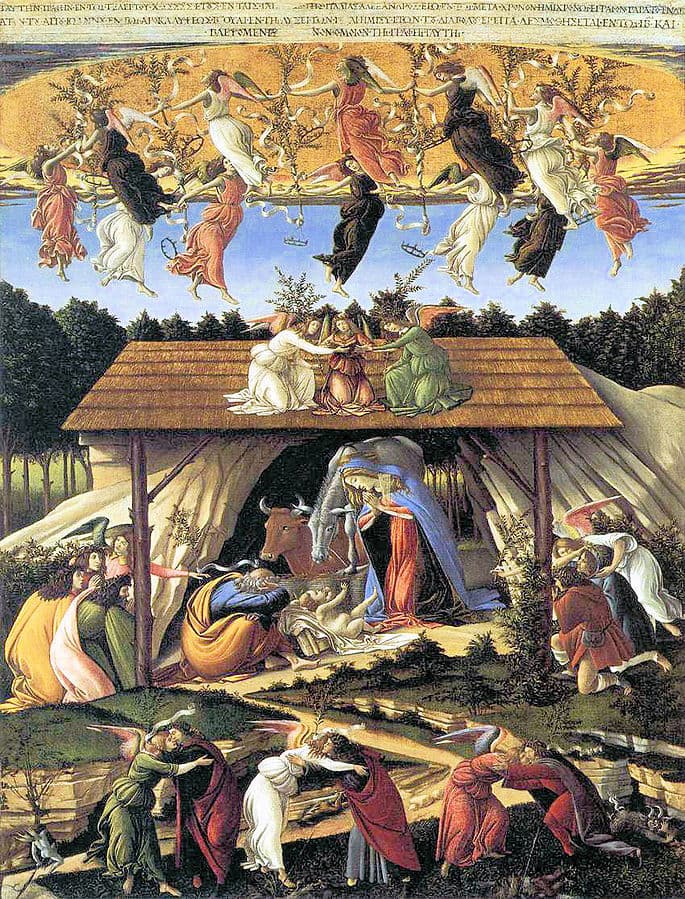
Sandro Botticelli: The Mystical Nativity
Mary lived in the town of Nazareth in Galilee. She was a cousin of Elisabeth and soon to be married to a man from the line of Kind David. He was a carpenter and woodworker by the name of Joseph. One day the angel Gabriel came to Mary and told her that she had been chosen by God to give birth to a son, whom she would name Jesus. But Mary was all confused, and the angel explained that the Holy Spirit would visit her and that the holy child would be called the Son of God. Throughout Christian history, the Virgin Mary held a significant role in worship, and she was officially accorded the title of Mother of God at the Council of Ephesus in 431. Prominent feast days in the church calendar were dedicated to her, and an enormous repertory of Marian music began to develop. The Virgin Mary received substantial musical attention during the turbulent centuries of the Crusades, and she became a popular subject of painting and poetry, often likened to a rose. Veneration of the Virgin Mary also played a significant role in the Counter-Reformation, and Pierluigi Palestrina provides a touching musical tribute to the grief experienced by Mary at the Cross.
Pierluigi Palestrina: Stabat Mater (Cambridge Singers; John Rutter, cond.)
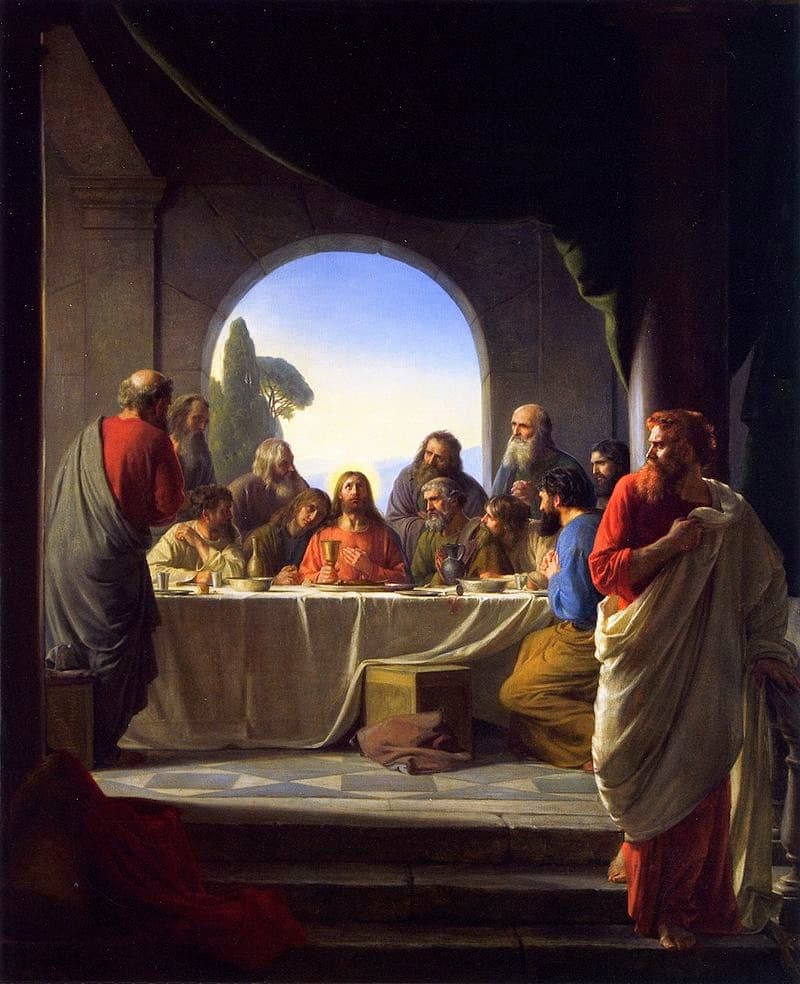
Carl Bloch: The Last Supper
In Christianity, the Passion is the final period in the life of Jesus. It begins with his triumphal entry into Jerusalem and ends with his crucifixion and his death on Good Friday. In the Passion narrative we find the events of the Last Supper, his arrest by the Sanhedrin priests, and his trial before Pontius Pilate. Accounts of the Passions are found in the four gospels, with Matthew, Mark, and Luke giving similar accounts, and John providing a slightly different account. The Passion narrative is normally read in one form or another by most Christian denominations during Holy Week. Of central importance to the Christian faith, the Passion has been numerously set to music. The first intonations appeared in the 8th century, and polyphonic settings took hold by the 15th century. Since then, Passion settings have been completed in a variety of styles and musical languages, but for me personally, nothing beats the musical setting by Johann Sebastian Bach in his St. Matthew Passion.
Johann Sebastian Bach: St. Matthew Passion (Jörg Dürmüller, tenor; Ekkehard Abele, bass; Cornelia Samuelis, soprano; Bogna Bartosz, alto; Paul Agnew, tenor; Klaus Mertens, bass; Amsterdam Baroque Choir; Amsterdam Baroque Orchestra; Ton Koopman, cond.)
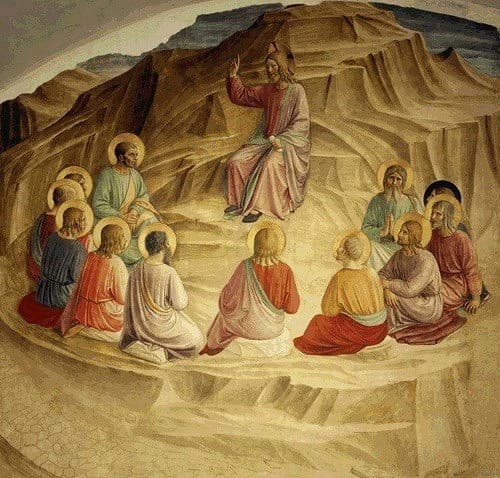
Fra Angelico: Sermon on the Mount
The “Sermon on the Mount” is a central episode in the life of Jesus. One evening Jesus went to a mountain with a crowd of people and disciples following him. But Jesus left them all behind and went to the mountaintop alone. He prayed all night, and in the morning he chose twelve men to preach the gospel to the world. He called them his disciples, and we now know them as “The Apostles.” We know relatively little about these men, but Peter and John appear to have been the leaders. To the surprise of everybody, Jesus also included Matthew, a tax collector. Then as now, tax collectors are almost universally hated and despised because they have a tendency to overcharge people. With his twelve apostles at his side, Jesus preached to a great many people and Matthew eventually wrote down the sermon. It includes some of the best-known teachings of Jesus, such as the Beatitudes and the Lord’s Prayer.
For more of the best in classical music, sign up for our E-Newsletter
Mario Castelnuovo-Tedesco: Evangélion, “The Sermon on the Mount” (Alessandro Marangoni, piano)

